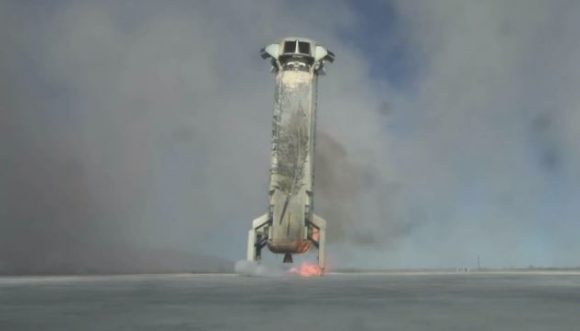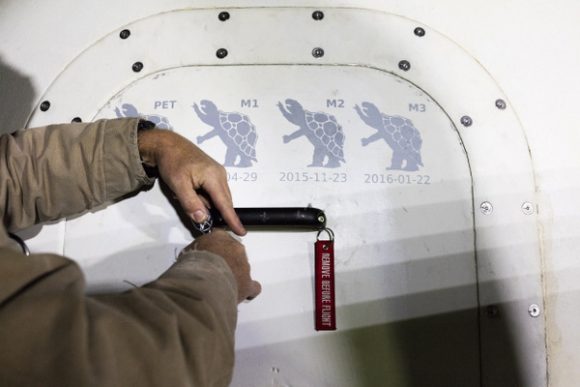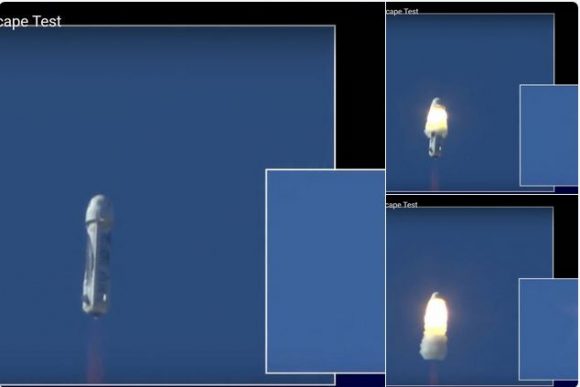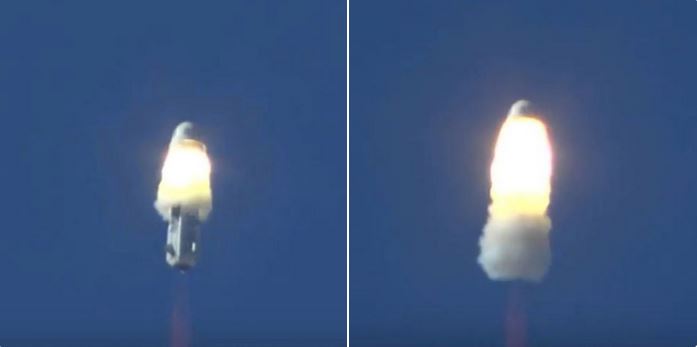Blue Origin successfully conducted an in-flight test of the New Shepard crew escape system on Wednesday. A live webcast featured stunning views of the crew capsule blasting away from the rocket booster 45 seconds into the flight with a two-second burn, and then parachuting safely back down to the ground. “We’re speechless right now and absolutely rightfully so,” said launch commentator Ariane Cornell.
Adding to the excitement, the rocket booster unexpectedly also survived the test, returning intact and making a successful vertical landing back at Blue Origin’s West Texas facility. So, yes, we were wrong about it ending in ‘fiery destruction.’ Blue Origin founder Jeff Bezos had said computer simulations showed a minimal chance the booster could survive the stresses of “70,000 pounds of off-axis force delivered by searing hot exhaust,” from the capsule escape motor, and then successfully return and land vertically as it’s done previously.
Bezos was pumped about the outcome, tweeting “That is one hell of a booster,” and included this Vine video of the event:
This is the fifth launch and landing of this rocket, the fourth made just this year. The successful landing of the booster means the intact rocket will find a place of honor – perhaps in a museum or even as a lawn ornament at Blue Origin, as SpaceX did.
Here’s the webcast:
This is the fifth launch and landing of this rocket, the fourth made just this year. The successful landing of the booster means the intact rocket will find a place of honor – perhaps in a museum or even as a lawn ornament at Blue Origin, as SpaceX did.
The escape system is designed to safely separate the New Shepherd crew capsule from the rocket booster in the event of an anomaly during flight, protecting a future crew. The abort system performed as expected, as about 45 seconds after liftoff, the escape motor ignited underneath the crew capsule. The motor burned for two seconds and shot the capsule up and away from the rocket booster. After a bit of tumbling – which would have given any occupants inside a fairly wild ride –the capsule’s parachutes deployed, allowing it to land safely. It will be interesting to hear followup on the tumbling from Blue Origin’s engineers, to see how unexpected that might be.
Cornel said this was a nominal test, providing an “exhilarating but safe ride.”

Once it was obvious the booster survived the blast from the escape system, it was fun and nail-biting to watch the booster reach the edge of space and then begin its descent. It used a series of braking maneuvers then just 8 minutes after launch as it approached the ground –still vertical — its BE-3 engine turned on and the landing legs deployed. The booster – looking only a little worse for wear — touched down gently.
Cornell said both the capsule and the booster will be retired, earning another turtle stencil.

Blue Origin hopes to launch paying passengers into suborbital space by 2018 and today’s successful test means the company is on track to make it so.
Today’s successful test flight won praise from many in the industry. Eric Stallmer, presdient of the Commercial Spaceflight Federation congratulated the Blue Origin team and said, “Today’s fifth successful flight proved the New Shepard’s most critical safety features, innovative escape system technologies, and overall robustness of their system. It’s an exciting time to see these fantastic technological advancements and to witness the power of commercial industry.”



Great flight and great coverage. Commentary team were excellent, informative, easy to listen to and no hype!
Escape + landing + booster-landing.
On the first try.